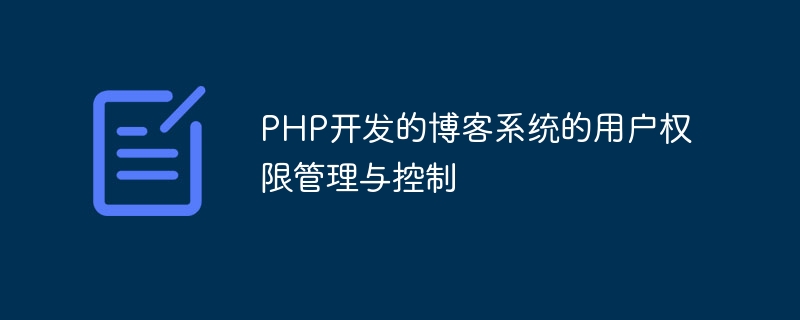

User rights management and control of the blog system developed by PHP
In a blog system, user rights management and control is a very important function. It can ensure that the operations performed by users in the system are within the scope allowed by their identities and roles, while also protecting the security of the blog system. In this article, we will introduce how to use PHP to develop a simple but powerful user rights management system, and provide code examples to help readers better understand.
First, we need to design a database to store user information and permission-related data. Suppose we have two tables: users (user table) and permissions (permission table). The user table contains basic information about the user, such as username, password, role, etc. The permission table stores permission information owned by different roles.
The following is an example of a simple user table:
CREATE TABLE users ( id INT(11) PRIMARY KEY AUTO_INCREMENT, username VARCHAR(50) NOT NULL, password VARCHAR(255) NOT NULL, role_id INT(11) NOT NULL, created_at DATETIME DEFAULT CURRENT_TIMESTAMP, UNIQUE KEY `username` (`username`) );
Example of permission table:
CREATE TABLE permissions ( id INT(11) PRIMARY KEY AUTO_INCREMENT, name VARCHAR(50) NOT NULL, description VARCHAR(255) NOT NULL, UNIQUE KEY `name` (`name`) );
User login is a common feature in many websites and applications. In our blogging system we will use username and password for authentication. The following is a sample code for a simple login page:
// login.php session_start(); if ($_SERVER["REQUEST_METHOD"] == "POST") { $username = $_POST["username"]; $password = $_POST["password"]; // TODO: 在数据库中验证用户名和密码 // 如果验证成功,将用户信息保存到会话中 $_SESSION["username"] = $username; // 跳转至首页或其他需要身份验证的页面 header("Location: index.php"); exit; }
In the user table, we have a role_id field to represent the user's role . We can use this field to determine which permissions should be assigned to a specific user. Store these roles in the role table of the database, each role has a unique ID and a name.
The following is a simple example of a role table:
CREATE TABLE roles ( id INT(11) PRIMARY KEY AUTO_INCREMENT, name VARCHAR(50) NOT NULL, UNIQUE KEY `name` (`name`) );
We also need an intermediate table to associate roles with permissions. The following is a simple example of a role permissions association table:
CREATE TABLE role_permissions ( role_id INT(11) NOT NULL, permission_id INT(11) NOT NULL, PRIMARY KEY (`role_id`, `permission_id`), CONSTRAINT `fk_role_permissions_roles` FOREIGN KEY (`role_id`) REFERENCES `roles` (`id`), CONSTRAINT `fk_role_permissions_permissions` FOREIGN KEY (`permission_id`) REFERENCES `permissions` (`id`) );
After a user logs in, we need to check the permissions of his role. To do this, we can check the user's permissions before each operation that requires permission control. The following is a simple sample code for checking user permissions:
// index.php session_start(); if (!isset($_SESSION["username"])) { // 用户未登录,跳转至登录页面 header("Location: login.php"); exit; } // TODO: 根据用户的角色获取其权限列表 // 检查用户是否具有特定权限 function checkPermission($permissionName) { // TODO: 检查用户的权限列表中是否存在需要的权限 return true; // 用户有权限 }
Using the above method of checking permissions, we can implement based on Permission access control. For example, we can only allow access to users with edit and delete permissions in the manage article page.
// admin.php session_start(); if (!isset($_SESSION["username"])) { // 用户未登录,跳转至登录页面 header("Location: login.php"); exit; } if (!checkPermission("edit_article") && !checkPermission("delete_article")) { // 用户没有编辑和删除权限,跳转至其他页面 header("Location: index.php"); exit; } // 显示管理文章页面 // TODO: 你的代码
Through the above steps, we can manage and control user rights based on the user's role and permissions. Of course, the above is just a simple example, and actual blog systems may have more complex permission requirements. By extending the above example, you can implement a more comprehensive user rights management system based on actual needs.
Summary
User rights management and control is a key function, which not only protects the security of the system, but also enables more flexible user control based on role and permission settings. In this article, we introduce how to develop a simple but powerful user rights management system using PHP and provide relevant code examples. Readers can implement the rights management function in their blog system based on these examples, and expand and optimize it according to actual needs.
The above is the detailed content of User rights management and control of blog system developed by PHP. For more information, please follow other related articles on the PHP Chinese website!




